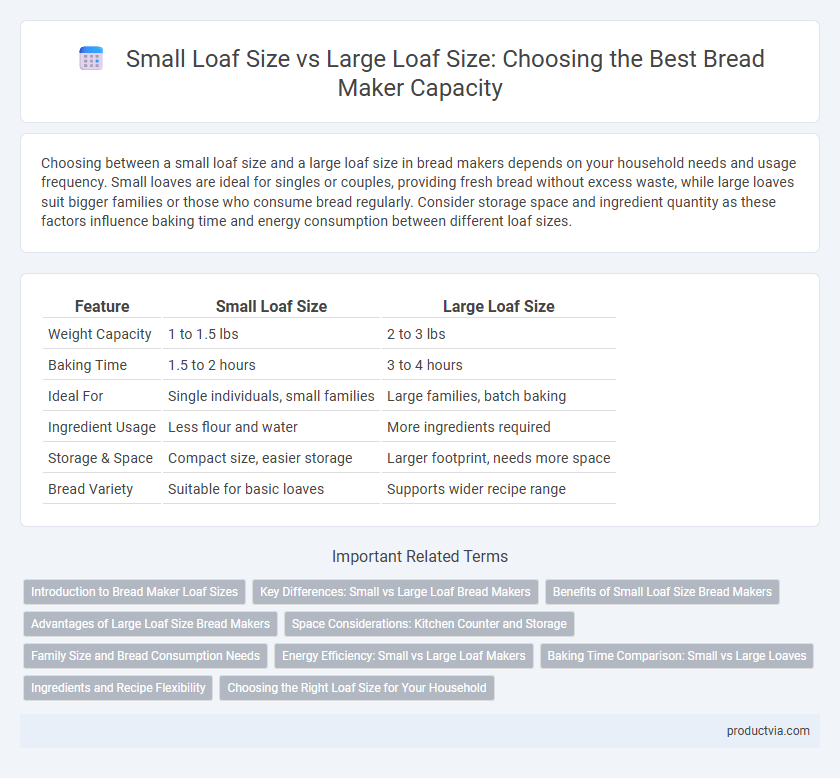Choosing between a small loaf size and a large loaf size in bread makers depends on your household needs and usage frequency. Small loaves are ideal for singles or couples, providing fresh bread without excess waste, while large loaves suit bigger families or those who consume bread regularly. Consider storage space and ingredient quantity as these factors influence baking time and energy consumption between different loaf sizes.
Table of Comparison
| Feature | Small Loaf Size | Large Loaf Size |
|---|---|---|
| Weight Capacity | 1 to 1.5 lbs | 2 to 3 lbs |
| Baking Time | 1.5 to 2 hours | 3 to 4 hours |
| Ideal For | Single individuals, small families | Large families, batch baking |
| Ingredient Usage | Less flour and water | More ingredients required |
| Storage & Space | Compact size, easier storage | Larger footprint, needs more space |
| Bread Variety | Suitable for basic loaves | Supports wider recipe range |
Introduction to Bread Maker Loaf Sizes
Bread maker loaf sizes typically range from small 1-pound loaves to large 2.5-pound loaves, catering to different household needs and consumption rates. Small loaf sizes are ideal for singles or couples, offering quicker baking times and less waste, while large loaf sizes suit families or those who prefer baking in bulk for longer storage. Selecting the correct loaf size ensures optimal bread texture and even baking, as bread makers adjust kneading, rising, and baking cycles based on loaf capacity.
Key Differences: Small vs Large Loaf Bread Makers
Small loaf bread makers typically produce loaves between 1 to 2 pounds, ideal for individuals or small families seeking fresh bread with minimal waste. Large loaf bread makers handle 2 to 3-pound loaves, catering to bigger households or gatherings that require more servings. The key differences include baking time, ingredient quantity, and storage space, with larger machines demanding more counter area and longer bake cycles to ensure even cooking.
Benefits of Small Loaf Size Bread Makers
Small loaf size bread makers offer the convenience of producing fresh bread without the risk of wastage, ideal for singles or small families. They require less energy and ingredients, making them cost-efficient and environmentally friendly. Compact size also ensures quicker baking times and easier storage, fitting seamlessly into limited kitchen spaces.
Advantages of Large Loaf Size Bread Makers
Large loaf size bread makers produce more bread per baking cycle, ideal for feeding larger families or meal prepping. They often feature adjustable settings to accommodate various recipes, ensuring consistent texture and crust quality. Investing in a large loaf size bread maker increases efficiency by reducing the frequency of baking sessions, saving time and energy.
Space Considerations: Kitchen Counter and Storage
Small loaf size bread makers are ideal for kitchens with limited counter space, as their compact dimensions allow for easy placement and storage in tight areas. Large loaf size models, while capable of producing more bread, require significantly more countertop and storage room, which can be challenging in smaller kitchens. Choosing the appropriate loaf size bread maker depends on balancing bread output needs with available kitchen space to maintain an organized and functional cooking environment.
Family Size and Bread Consumption Needs
Selecting a bread maker with an appropriate loaf size is essential for meeting family size and bread consumption needs effectively. Small loaf sizes, typically around 1 to 1.5 pounds, suit individuals or small families with limited bread consumption, minimizing waste and preserving freshness. Large loaf sizes, ranging from 2 to 2.5 pounds, accommodate bigger families or higher bread demand, ensuring sufficient portions and reducing the frequency of baking cycles.
Energy Efficiency: Small vs Large Loaf Makers
Small loaf bread makers consume less energy per baking cycle due to shorter baking times and lower dough volume, making them more energy-efficient for regular home use. Large loaf bread makers, while using more energy per cycle, offer better energy efficiency relative to the amount of bread produced, ideal for families or batch baking. Choosing the right size balances energy consumption with bread quantity needs, optimizing overall efficiency.
Baking Time Comparison: Small vs Large Loaves
Small loaf sizes in bread makers generally bake faster, typically requiring 2 to 3 hours, while large loaves take 3 to 4 hours due to increased dough volume. The shorter baking time for small loaves results from quicker heat penetration and reduced moisture retention, affecting crust texture and crumb density. Large loaves demand longer baking to ensure even cooking, which can influence energy consumption and texture uniformity in the finished bread.
Ingredients and Recipe Flexibility
Small loaf size bread makers require precise ingredient measurements to ensure proper dough consistency, offering greater control over recipe customization and experimentation with unique flavor combinations. Large loaf size models accommodate more ingredients, making them ideal for family-sized portions but may limit the flexibility to modify recipes due to bulk quantity adjustments. Choosing between small and large loaf sizes impacts ingredient scaling, baking time, and the ability to tailor recipes to specific dietary preferences or ingredient availability.
Choosing the Right Loaf Size for Your Household
Selecting the proper loaf size for your bread maker depends on your household's consumption and storage capacity. Small loaf sizes, typically around 1 pound, are ideal for singles or couples as they reduce waste and stay fresh longer. Larger loaf sizes, such as 2 to 2.5 pounds, suit bigger families or those who consume bread daily, ensuring enough supply while maximizing the bread maker's baking efficiency.
Small loaf size vs Large loaf size for bread makers Infographic

 productvia.com
productvia.com